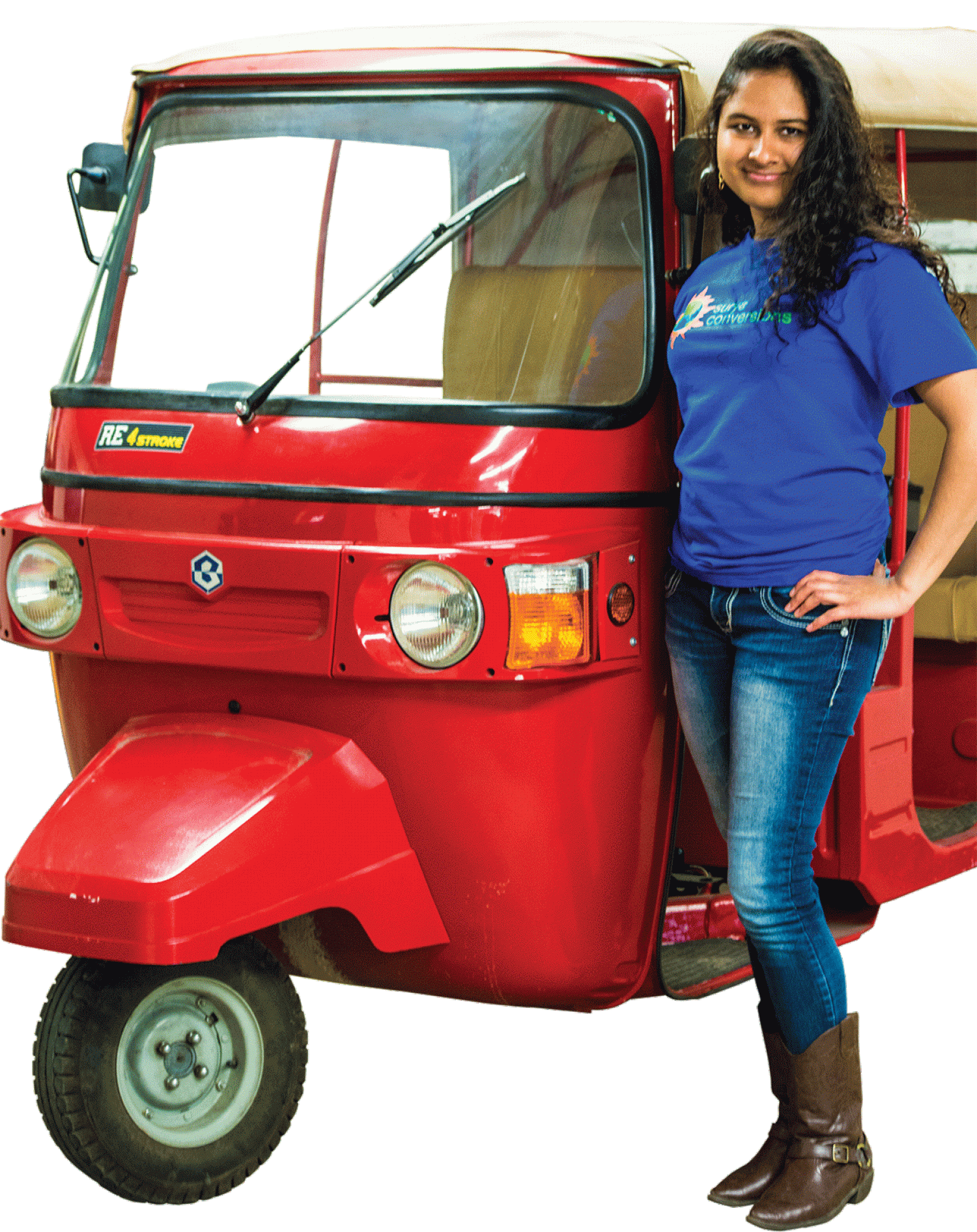
Revolutionizing the Rickshaw

A CU Boulder engineer aims to revolutionize local transportation in India. She's 23.
If you’ve been to a big city in India or China, you’ve probably ridden in a motorized rickshaw. They’re the low-cost, three-wheeled taxis commuters use for short trips — that last mile or two from the train station to home or from home to the store — and a key piece of the urban transportation network.
But rickshaws are also a massive source of pollution, as Maithreyi Gopalakrishnan (EngrPhys, MApPhys’16) noticed during visits to see relatives in Chennai.
“Every year we go back, the pollution gets worse and worse,” said the recent CU Boulder graduate, whose family moved to Superior, Colo., from India in 1993.
Most of India’s motorized rickshaws, and there are millions of them, are older models equipped with simple two stroke engines — notorious polluters. They contribute up to 40 percent of vehicle pollution in India’s largest cities, according to Gopalakrishnan, 23.
In 2014 she decided to do something about it. Then a sophomore in the College of Engineering & Applied Science, she founded a company to design and develop a hybrid conversion kit for rickshaws that would benefit the environment and rickshaw drivers alike.
“If all of India’s auto rickshaws are equipped with one of our kits, we estimate it’s the equivalent of taking one million cars off the road,” she said.
The company, Surya Conversions (Surya means “sun” in Sanskrit), is a start-up to be sure. The firm is still perfecting its prototype and hasn’t brought its product to market yet. Stateside, the prototype has been tested on one rickshaw, a poppy red, four-stroke import that narrowly met U.S. air pollution control standards.
But things are going well: Surya raised $30,000 through grants, competitions and a Kickstarter campaign, and won the 2014 CU Boulder New Venture Challenge’s Social Impact Competition, claiming a $3,000 prize. A year later, it won the Boulder Chamber’s 2015 Esprit Venture Challenge and a check for $10,000.
All this — plus a lot of time, energy and brainpower from more than a dozen of Gopalakrishnan’s fellow CU students — led to the 35-pound prototype she took to Chennai for a series of field tests this fall. Data collected there about fuel consumption, emissions and other performance data will inform improvements.
Preliminary tests indicate Surya’s kit could cut fuel costs by $600 a year — equal to the conversion kit’s anticipated $600 price tag, Gopalakrishnan said. That means fuel savings could pay for the kit in a year’s time.
This is important, because drivers don’t earn much — annual take-home pay is roughly $1,800, she said, “barely enough to support a family,” nevermind invest in a new all-electric, electronic or compressed natural gas-powered rickshaw, which typically cost several thousand dollars.
With the Indian government pressuring rickshaw drivers to switch to cleaner models, Surya’s conversion kit could become an affordable alternative.
During those family trips to Chennai, Gopalakrishnan would watch the colorful parade of open-air rickshaws weave through the city’s streets.
At CU, her growing knowledge of physics led her to realize the kinetic energy produced by rickshaws’ constant braking in stop-and-go traffic could be harnessed to generate electricity. Existing hybrid vehicles, such as the Toyota Prius and the Ford Fusion Hybrid, use regenerative braking to recharge their batteries — why not harness the same technology to convert a gasoline-powered rickshaw into a hybrid?
Working with other students, including lead engineer Irfan Nadiadi (MMechEngr’17), Gopalakrishnan developed an easy-to-attach hybrid conversion prototype that could be installed without modifying the vehicle itself.
When a rickshaw’s brakes are applied, the device traps energy that would otherwise dissipate as heat and stores it in the kit’s battery. Power is then transferred to the engine, allowing the vehicle to operate primarily in electric mode when it’s idling or traveling at lower speeds. This results in fewer fill-ups and less total emissions, she said.
A place to start: Earth's second-most populous country."
Gopalakrishnan, Surya’s chief executive officer; Kimberlee Ott (EnvEngr’15; MCivEngr’17), chief operations officer; Sam Winston (Acct’15), business operations and now also with GitHub; and Nadiadi eagerly await the results of the field tests in India.
If the prototype cuts emissions sufficiently — the goal is 25 percent or more — Gopalakrishnan will try to raise $400,000 and begin producing the kits.
It could be just the start of something much bigger, she said: “Another 35 countries use auto rickshaws. We’d like to bring the kit to the rest of the world.”
That’s potentially a huge business coup, and something perhaps more satisfying, too.
“I got interested in engineering as away to help people,” said Gopalakrishnan, who is also a trained ballet dancer. “I saw engineering as a way that I could transform an idea into a meaningful and useful product.”
George Deriso, an experienced technology entrepreneur and advisor for CU Boulder’s Deming Center for Entrepreneurship who has advised the Surya team, believes the rickshaw hybrid conversion kit is just the beginning for Gopalakrishnan.
“I believed her invention was one of great importance, in that it could potentially improve the lives of millions in those countries that use auto-rickshaw vehicles,” he said. “As I got more acquainted with her, I came to realize that Maithreyi herself is the real potential.”
Photo courtesy Maithreyi Gopalakrishnan

